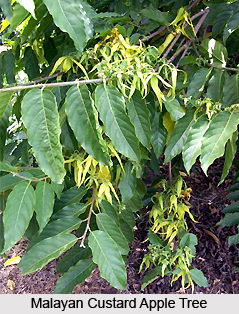The Malayan Custard Apple is an Indian medicinal apple that is widely grown in the sub continent. The scientific name for this plant is Cananga Odorata. Besides, the name of the Malayan Custard Apple varies from region to region. While in Kannada it is known as `Apurvachampaka,` in Tamil it is called Karumugai, Maladi, Maramanoranjidam, Sadi, Sirusam-Pagam and in Telugu Malayan Custard Apple is called Apporvachampakamu and Chettu Sampengi.
 The Malayan Custard Apple generally grows upto 30 metres and its bark has brownish-grey fissures. Apart from this the Malayan custard apple is also grown to extract essential oil called `ilang ilang.` The leaves of this medicinal plant grow at alternate branches with 9-20 cms in length, 4-9 cms in width and their shapes vary from ovate-oblong to elliptic. The margins of the leaves are waved, apex finely acuminate, slightly juvenile beneath, with an asymmetrical base and the veins are sideways including midrib at an angle of 45 degrees. The petioles are about 1 cm long.
The Malayan Custard Apple generally grows upto 30 metres and its bark has brownish-grey fissures. Apart from this the Malayan custard apple is also grown to extract essential oil called `ilang ilang.` The leaves of this medicinal plant grow at alternate branches with 9-20 cms in length, 4-9 cms in width and their shapes vary from ovate-oblong to elliptic. The margins of the leaves are waved, apex finely acuminate, slightly juvenile beneath, with an asymmetrical base and the veins are sideways including midrib at an angle of 45 degrees. The petioles are about 1 cm long.
The flowers of Malayan Custard Apple grow twice annually and are known for their fragrance. These are 7.5 cms long, sagging, green at first and then turns yellow with a purple-brown blot at the internal base. The outer petals are 0.8-1.2 cm wide and the inner ones are almost 0.5-0.7 cms wide. The fruits or the berries of this medicinal plant are oblong-ovoid in shape with 1.5-2.3 cms length. The innumerable berries blooming in Cananga Odorata or Malayan Custard Apple are glabrous, nearly black when ripe and pulpy. These berries have around 12 seeds that are pale brown and pitted.
The fresh flowers of Malayan Custard Apple are known for their important medicinal quality for the treatment of asthma. An infusion of the flowers is used after bathing or sometimes rubbed on the skin to prevent skin itching. The essential oil obtained from the flowers is used as an application for healing headache, ophthalmia and gout. The leaves are used for treating diarrhoea in infants and are rubbed on the skin to reduce itching and boil. The fruits and seeds of Malayan Custard Apple are used for treating fevers. The bark of this tree is rich in alkaloids and is sometimes given as a decoction for treatment of ophthalmia, rheumatism, phlegm, ulcers, and fevers and also to improve the complexion.



















